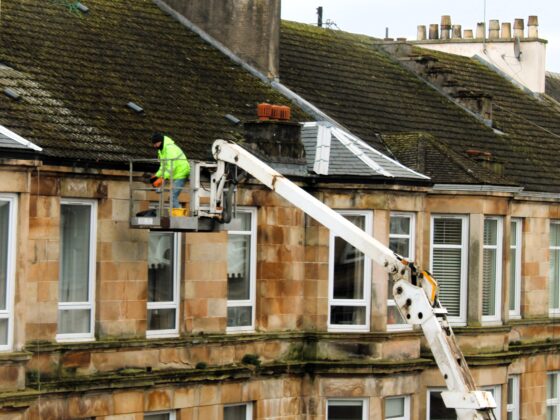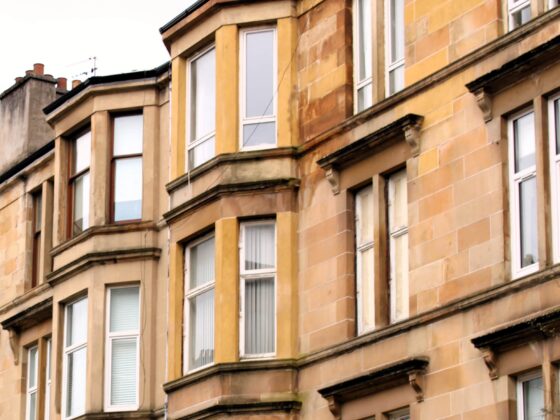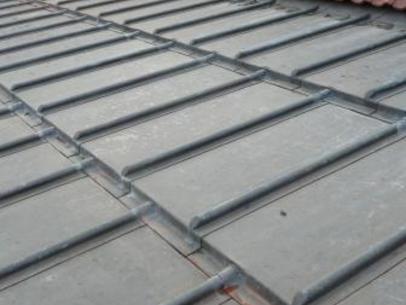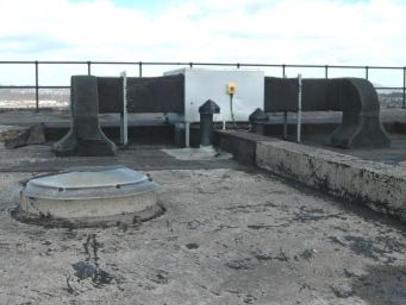
“Tenements are a big doorway into history.” Photo courtesy of Diarmid Mogg.
Diarmid Mogg is the founder and curator of the project Tenement Town, a website where he posts photographs of old tenement doorways in Edinburgh and the stories of the people who once lived there.
It all began in summer 2022, when the doorway of an old Victorian tenement on South Clerk Street caught Diarmid’s eye as he was out for a walk.
“[The doorway] was in an astonishing state of disrepair, with stickers and spray-painted tags all over it. It looked like it hadn’t been painted in decades. But you could see that the tenement itself had been a good property when it was built. That whole area of South Clerk Street was built for upper middle-class families and professional tradespeople. I thought, there’s something going on with that building, it’s clearly been through a lot.”
As Diarmid stood outside 25 South Clerk Street, he looked up the address on the British Newspaper Archive website and unearthed stories about its former residents: a retired baker who fell out of a window and was impaled on the railings; another of a man who died of gangrene after a metal box fell on his toe in Dublin; and yet another of a man whose car was blown off the seafront in Aberdeen.

25 South Clerk Street in Edinburgh. The doorway which inspired the project. Photo courtesy of Diarmid Mogg.
“These individual stories weren’t that big a deal on their own. But if you string them all together, especially chronologically, you get an impression of the life of the building through its residents.”
He started researching other notable doorways around the city. Each revealed the stories of interesting past lives that had made the papers in the last 150 years or so. And the project, Tenement Town, began.
Diarmid’s interest primarily lies in social history and how ordinary people used to live because it’s often the details of daily life which are forgotten. He also appreciates the unique architecture of tenements and how they are a “doorway to history”. The project has led him to notice their particular features, such as transom windows that let light into a close.
“In the cheaper tenements, [transom windows] are just a square or rectangle of plain glass. But in some buildings, they are wonderful. There’s a great one up by Nicolson Square, right beside the KFC. It’s a beautiful circle with spokes coming off it, and from inside the close it will create this circular sun effect.”
The stories Diarmid uncovers are also a reminder of darker historical truths, particularly that of the glaring injustices that women faced during the Victorian era.
“The deal was comfort, security, and a maid, but in return a woman lost every bit of agency they might possibly have in their life. All the divorce stories are appalling; the things that the men could do, and the things that women could not do. Of course, we already know this, but it’s striking to come across.”
Another notable finding affecting some of the women in these stories is the number of deaths recorded due to the wearing of crinolines.
“There is story after story, especially from about 1860-1880, of women constantly being set on fire in their homes. Crinolines became a very fashionable item, but women were horrifically burned, scarred or even died because of them. It’s something we just don’t think about when we see them worn in costume dramas.”

A tenement doorway on Nicolson Street in Edinburgh with a transom window. Photo courtesy of Diarmid Mogg.
One of Diarmid’s most profound tales is one which lies behind the doorway of 13 East Preston Street, a building he frequently passes. Behind this average doorway lies the story of a woman called Helen Pairman who kept lots of secrets. The most elaborate, and eventually revealed, of these secrets was her affair with her doctor. The doctor would visit Mrs Pairman with flowers hidden under his hat and would know when to do so as she would place a flowerpot by her window, signalling for him to come by.
The stories that Diarmid has come across, some of his own choosing, some requested by relatives of those who once lived in the tenements, have a cumulative effect: the tenements become a community of buildings with stories attached and it brings those people to life.
“As you walk through the city with this awareness of these people that came before you and existed in these different areas that you’re in now, you have this feeling that you’re surrounded by these old ghosts… you can imagine the sort of lives that were lived in the streets where you live, and you see the things that they will have seen. Some of the doors are very old, and if you happen to be inside one of the closes, the bannisters, the rails, all those kind of things, they were touched by these people that you now know about. You really feel you’re living alongside these past lives.”
Many of the tenements in Edinburgh, and the rest of Scotland, will have similar stories, mini histories waiting to be discovered. If you’d like to find out about the people who once lived in your tenement building, get in touch with Diarmid and he may be able to help.





